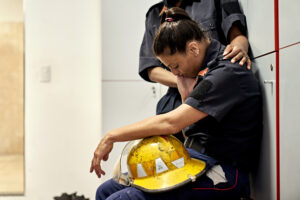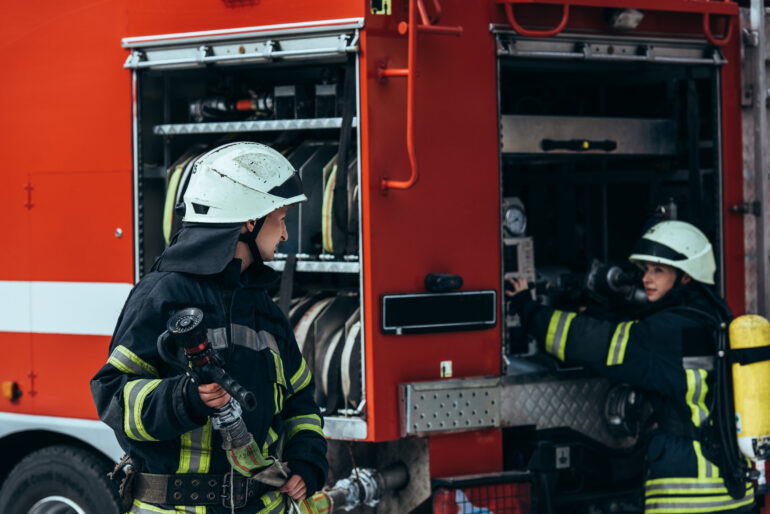Disincentives to access therapy
More than one therapist I spoke with referenced the film Departed as how they thought law enforcement and first responder mental health worked. Not quite.
I spoke with Dr. Kristen Wheldon of the Fire Service Psychology Association. She worked for a fire department in a major city and was the sole psychologist for a time. “I’m one to 3,000 sworn, meaning there’s one psychologist to 3,000 in the fire department.” She did a deep dive to understand why the fire service didn’t have better mental health resources.
Law enforcement first encountered psychologists as part of their hostage negotiation programs in the mid-20th century. Psychologists were later trusted in other roles such as pre-employment screenings and clinical psychotherapy work. First responders had no such early relationship with psychology, so there’s no first responder-specific pre-employment screening assessments. We don’t even have a suicide risk scale for the fire service. Fire service psychology is about 20 years behind law enforcement psychology.
The first intervention after a potentially traumatic incident is called “debriefing.” These are non-clinical group sessions provided through the department or an outside team. Imagine doing group therapy with your coworkers. These debriefings range from helpful to harmful, depending on the experience of the facilitators and the culture of the department. I asked first responder specialists what kind of feedback their clients had about debriefing and one told me: “All [of their clients] reported negative experiences and lack of trust in that process [of debriefing.]” None of the organizations I spoke with believe that debriefings alone are sufficient to address first responder mental health, but many departments still offer them as their sole mental health intervention.
The second intervention is therapy. There are layers of liability involved in a department assessing mental health distress that could later turn into a worker’s compensation claim, so installing 100 therapists into every fire department in the country is not the easy fix to this problem. Trust me, all of the “easy” solutions have already been tried. The reasons why first responders don’t go to therapy have been exhaustively documented in the literature and include fear of negative repercussions, fear of job loss, stigma around mental illness, and fear that their bosses will find out what they talk about in therapy (Gist, 2011; Crampton, 2012; Dill, 2023).
Many departments have counselors contracted through a request for proposal (RFP) process, where an organization requests for contractors (clinicians) to offer services. Many RFPs require experience of up to five years working with that population in order to apply. These clinicians are guaranteed to be qualified, but openings are limited based on contractor availability. Clinician incentive is low since these contracts will never be as lucrative as the cash-pay private practice market.

Meanwhile, other departments contract with EAP companies. These panels contract their own providers and then sell their service to many different organizations, so there’s often no one with actual first responder experience on these panels. They offer lower rates than managed care contracts which means there’s no incentive for these therapists to get extra training.
It is hard to understate how awful the typical EAP experience is, but I will attempt to be fair. I spoke with Jason Mills, a former firefighter, medic, and flight medic who is now the CEO of “The Resilient Responder,” an organization that does consulting work with law enforcement and first responder departments. I asked him what first responders thought about EAP and he told me EAP was: “notoriously regarded, and still regarded as a waste of time mostly because the competency and more specifically cultural competency of those providing the service had never been established. The people taking calls for firefighters struggling after a mass casualty event were the same ones talking to the teachers about the stress of interacting with unreasonable parents.” I recently encouraged a friend in law enforcement to seek therapy and he used the EAP through his department. His therapist missed their first two appointments and when she finally showed, she had to re-read her notes in session because she’d forgotten him. Speaking to others who have used EAP, this is not an uncommon experience.
And then there are the consequences of seeking help. Kelly Lynch, a former EMT, founder of Turning Point Wellness, and a consultant for first responder mental health told me: “If someone is struggling, whether it’s with the field overall, a particularly traumatic call, or the vicarious trauma and compassion fatigue all first responders battle with, they slowly become viewed as ‘weak’ as a result of their struggle, which then translates into questions of reliability, creating the perception that someone isn’t as trustworthy as a partner as they need to be.” Many first responders choose to repress symptoms rather than be ostracized by their coworkers. A firefighter in a Western state explained what burnout looks like: “With time, they just accept their feeling of emptiness, lack of motivation, distancing, anger, sleep deprivation, etc. as being something that likely has nothing to do with the root cause.”
I asked Daniel Crampton, a retired paramedic who is now a psychologist specializing in first responders and the COO of Status Code 4, an organization that provides counseling to first responders, “If I were an EMT and my bosses found out that I was getting therapy, what could happen to me?” He said “There are still some departments that if you show any mental health issues, they’re either going to put you on light duty, or get you ready for medical retirement.”
I then asked him what should happen in a perfect world. I had to clarify three times the concept of ‘perfect world,’ because what should happen is truly a fantasy. He said that as my hypothetical boss, he would compassionately speak with me about what I’m going through and then offer me two weeks off. “So that when you come back and you go on another call, you’re not going to be further injured by that mental trauma.” Which sounds more cost-effective than burning out your employees and paying for FMLA claims. In his 2012 dissertation, Crampton did a survey and found that Employee Assistance Programs were offered to 71% of the urban paramedics surveyed and 48% of rural, (Crampton, 2012), so if EAP can be improved, it may be a part of a solution to the first responder mental health crisis. However, the problem of incentivizing therapists to join insurance panels persists. The problem isn’t just getting first responders into therapy, it’s getting therapists into this market.
Dismantling myths about who sees first responders
I had a hard time finding therapists who specialize in first responders. Ironically, I was looking for people to ask “Why don’t more therapists work with first responders?” There is no APA division for first responders, no central database for me to crawl through, and the population “first responders” is not a clickable link on PsychologyToday. I initially made a post in a Facebook group pretending I was looking for a referral for a first responder, but when I messaged some of the respondents, they confessed they had no experience, they just wanted a cash-pay client.
An introduction in case you’re new to this field: The first thing anyone tells you when you think about joining their niche is “don’t,” because they don’t want the competition. When people told me I needed cultural competency training to work with first responders I rolled my eyes. However, without exception, every single person I interviewed told me I needed training and the literature agreed. Of the first responder specialists I spoke with, a majority had done some kind of training (82.14%), which is noteworthy because nearly all of the respondents were former first responders (35.71%) or related to one (57.14%).

Why should you care about cultural competence? At a conference this year, I heard a firefighter share that the FMLA paperwork completed by his therapist, who claimed to specialize in firefighters specifically, was rejected because masters-level clinicians cannot complete this type of paperwork in his state. Having his claim denied became a secondary trauma for him. This is just one example of things that could go wrong. One firefighter who’d gotten his own treatment told me that “any therapist would be fine, even without special training,” and then told me a horror story about his therapist apologizing to him in session. I’ve read online posts from therapists describing ‘interventions’ that consist of almost the exact opposite of what’s advised in the acute stress literature. I’ve read even more therapists repeat unfounded claims from trainings they’ve done that such-and-such intervention is neuroscience based and therefore, they can work with any age, race, gender, sexual identity, or other unique population without any prior experience.
I have concluded that while a lot of us are scrappy enough to figure out how to work with a new population on the fly, many are not.
Here’s the problem: I don’t know if cultural competence training for first responders improves outcomes and there are no studies about this. The Fire Service Psychology Association is rolling out a new training program for clinicians and they plan to track outcomes to measure efficacy. I can tell you that no, I don’t think this type of therapy work is suitable for everyone, and completing a training won’t change that for you.
I asked Daniel Crampton of SC4I what he thought about training and he said “You don’t know what it’s like to look in the eyes of a dead child until you’ve looked into the eyes of a dead child.” Stephanie Carney, a first responder spouse and counselor told me “I do think living with first responders my whole life has been my most valuable experience. No training could teach me the things I have learned from that.”
First responders seem to prefer therapy with someone who has shared lived experience. One firefighter in an eastern state told me that the CISM guy who talks to his team “hasn’t been in an ambulance since it was a Cadillac,” but his guys would still rather talk to him than me, a licensed therapist who has never been in an ambulance.
I needed to know why more therapists don’t work with this population, considering so many are “trauma specialists” now. I cold-emailed 73 first responder specialists and got 28 to talk with me on the phone, email, or complete an anonymous survey. I defined “specialist” as someone who saw five or more first responders in the last year, which is about a quarter of an average caseload. I defined ‘first responder’ as EMT, firefighter, ER, or frontline nursing staff because there is overlap in these populations. Many EMTs work in the emergency room and many therapists that see firefighters also see emergency room staff. I asked specialists why they think more therapists don’t work with this population and why.
I want to mention some of the less-common responses, because they are important:
- Because first responders are on call and too difficult to schedule with
- Many first responders want to do therapy in person but a lot of therapists stopped offering in-person sessions after the pandemic
- Therapists wouldn’t know how to talk to departments or handle worker’s compensation paperwork and they don’t want to learn
These were the most common answers:
- 60.71% believe therapists don’t understand the culture of first responders
- 53.57% believe therapists can’t handle the kind of trauma first responders have
- 21.43% believe some therapists are too “woke” and hate first responders

I needed to know how much of this was true, which meant finding clinicians who don’t work with first responders and asking them. I looked within the natural habitat of master’s-level clinicians, which is Facebook, and found over 100 respondents from 30 different Facebook groups all over the country. Respondents were asked five questions and allowed to check as many answers as they liked. I put a comment box at the end and it was the most reckless decision of my life. Forty-six respondents wrote in comments, which is much higher than I thought I would get.
This survey turned into a measure of therapist hubris. I got four answers where people mentioned they had some “trauma training” (three mentioned EMDR by name) and thus they thought they’d work well with first responders even with no experience. One respondent said “I don’t think of first responders differently than my other clientele. For reference, I’m a trauma therapist.”
To be clear, I am not saying that therapists don’t need cultural competency or that they can handle the trauma of first responders; I am saying that therapists who do not work with this population assume this to be true.
I asked how much clinicians were willing to pay for cultural competence and the most popular response (37.50%) was “I would pay $500 max.” A lot (26.92%) indicated they would do training “online only.” This means that most trainings do not accommodate the preferences of therapists. I could only find a few online trainings for less than $500, and they all had an in-person requirement for ride-alongs, citizen academies, or site visits. First responder specialists say the in-person experience is the most important part. Daniel Crampton advised interested therapists to just complete the EMT training.
Thirteen respondents (12.50%) said they don’t think they need cultural competence training because they have “family or friends” who were first responders. Many first responder specialists I spoke with consider this adequate.
However, 30 other people who don’t have first responder family or friends, said they don’t think they need training. Of these, 23 said they already have “cultural competence training” or experience “some other way” (the others selected an option saying they just don’t think it’s necessary). Twelve shared a comment about what this relevant training was, and it was insightful. Only seven of these ‘cultural competence with first responder experiences’ mentioned actual experience with first responders. Five shared training that I consider insufficient and these include generic trauma training. I would bet the remaining respondents are also talking about trauma trainings that promise universal applicability, such as EMDR.
Most (67.86%) of the first responder specialists I talked to took some kind of insurance. I thought insurance might be a deterrent for working with this population because of the growing number of therapists leaving panels. The survey responses were mixed.
Over a quarter of respondents, 26.92% (28 people) said they were not interested in going on insurance for first responders, but a majority (55.77%) said they already took insurance. A small percentage were willing to negotiate a contract with a department (15.38%) or get on an insurance panel just to see first responders (11.54%). I’ve interpreted these data as follows: Therapists will not do any extra work to see first responders. If one comes in, they will see them. I made that a response to a survey question: “Are you interested in working with first responders?” A staggering 67.31% (70 people) checked the option “Neutral, if one comes to my practice I’ll see them.”
I tried to gauge therapists’ interest in seeing this population. Almost a quarter (19.23%) said “I would do training if it meant I could see more,” which makes me hopeful. A few (15.38%) said they were “Actively trying to see this population,” which as per the survey requirements means they’d seen less than 5 in the last 12 months. I want to know why it’s been so hard for them. My best guess is that they are waiting for this population to seek them out instead of actively networking with them, or these clinicians don’t take insurance.
To the point that therapists don’t work with first responders for political reasons, this just isn’t true. Only a sliver said they were “not interested” (7 people, or 6.73%) in working with first responders or answered “No, I would not see a first responder” (4 people, or 3.85%). There was overlap between these answers and of the seven unique respondents, four mentioned they didn’t want to see first responders because they were sensitive to gore, not because they were “woke.” One said they would take “anybody but police” and another said they were worried about their ability to maintain “unconditional positive regard” if their first responder client talked about harming a “marginalized person,” which I think is a reference to police. That’s only three people out of a hundred and four (if you count the two who don’t like police. They might still see firefighters or EMTs, for example). I posted in 30 groups, including a few that might be considered leftist niches. Myth debunked: Woke therapists will totally see first responders.

Many specialists said that therapists couldn’t handle the kind of trauma that first responders have. This is probably true, but do therapists think this is true? When asked whether they could listen to content that involves “blood, injury, and mutilation,” results were about evenly split between the ‘yes’ options:
“I do this all the time in my practice already” (30.77%)
“I don’t do this all the time but I’m open to it” (35.58%)
“I would have to set up breaks in my schedule if a client talks about this regularly” (36.54%)
Ninety-nine unique respondents out of 104 (95%) said “yes,” they could listen to content that involves blood or mutilation. In other words, whether or not they have experience or the capability to handle first responder trauma, over 95% of respondents think they do. Of the five people who left a comment saying they are sensitive to blood or gore, three of them said they would still do it, including the one commenter who said “If you’re ‘comfortable’ listening to this type of talk, you’re either dissociated yourself or you’re vicariously traumatized,” and indicated on the survey, “Yes, I do this all the time in my practice already.”
Of the eight respondents who said, “I would see almost anyone if they were willing to pay out of pocket,” half (four) said they already listen to gory content all the time and the other half said they don’t, but they are open to it. Two of these respondents also checked the box that if a client did it all the time they’d have to set up breaks, maybe indicating they’re unsure if they could handle this.
I chose the language of the question carefully. There’s no APA division for the fire service so they have to borrow from other fields. A white paper (Gist 2011) suggested some scales that may be applicable to the fire service, including the Mutilation Questionnaire. Early research shows that sensitivity to blood and mutilation-related stimuli as measured by this tool might be a predictor of PTSD for special forces (Naifeh 2011). This is where I went out on a limb. Assuming it is, and assuming most first responders who go to therapy go for PTSD, they might talk about mutilation content. I didn’t just pick the worst thing I could think of, I picked it because it’s probably common. I think it’s significant that most therapists would sit through content that makes them uncomfortable. I’m not sure if the response “I need to take breaks” indicates therapists with good boundaries or bad ones. I’m not sure if these therapists hide their discomfort with this content as well as they think they do.
“There are many therapists who say they work with first responders, but are saying it out of curiosity or wanting to rubber neck, but not because they are actually competent to work with them.”
Overall, my takeaway from this survey was that nobody is going out of their way to see first responders. It makes the lack of accessible quality cultural competence training almost a moot point since I don’t think anyone would do it even if it were available. It is not a profitable niche. It is not an easy demographic to work with. The allure of helping heroes is also a downfall, since as one anonymous first responder specialist mentioned, “There are many therapists who say they work with first responders, but are saying it out of curiosity or wanting to rubber neck, but not because they are actually competent to work with them.”










